County health officials were interested in studying the possible health benefits of dog ownership. They conducted the two studies described below.
Study 1: Using county records, a random sample of 50 county residents who own a dog was selected and a random sample of 50 county residents who do not own a dog was selected. Blood pressure was measured for each of these 100 people. Based on the results, the county officials concluded that the mean blood pressure for dog owners was significantly lower than the mean blood pressure for those who do not own a dog.
Study 2: One hundred county residents who did not own a dog and who volunteered to participate in the study were assigned at random to one of two groups. Those in group 1 were given an adult dog. Those in group 2 were not given a dog and agreed not to get a dog during the next year. After one year, blood pressure was measured for each of these 100 people. Based on the results, the county officials concluded that the mean blood pressure for dog owners was significantly lower than the mean blood pressure for those who do not own a dog.
(a) Would either of the studies allow the county officials to conclude that owning a dog is the cause of the observed difference in blood pressure? Explain.
(b) Would either of the studies allow the county officials to generalize the findings to all county residents? Explain.
Overview of the question
This question is designed to assess the student’s ability to:
1. Recognize when it is reasonable to draw a cause-and-effect conclusion based on the design of a statistical study (part (a)).
2. Recognize when it is reasonable to generalize from a sample to a larger population based on the design of a statistical study (part (b)).
Standards
7.SP.1: Understand that statistics can be used to gain information about a population by examining a sample of the population; generalizations about a population from a sample are valid only if the sample is representative of that population. Understand that random sampling tends to produce representative samples and support valid inferences.
S-IC.1: Understand statistics as a process for making inferences about population parameters based on a random sample from that population.
S-IC.3: Recognize the purposes of and differences among sample surveys, experiments, and observational studies; explain how randomization relates to each.
Ideal response and scoring
Part (a):
Part (a) asks to consider two study descriptions and to indicate if it is possible to draw a cause-and-effect conclusion (that owning a dog is the cause of the observed difference in blood pressure for the two groups) based on the results of either of these studies. An ideal response to part (a) is one that recognizes that cause-and-effect conclusions can only be drawn from the results of a well-designed experiment. Because Study 1 is an observational study and Study 2 is an experiment, a response that indicates that the stated conclusion is only appropriate for Study 2 because it was an experiment and because subjects were randomly assigned to the two treatment groups (dog and no dog) is essentially correct. To be considered essentially correct for part (a), the explanation given must note the role of random assignment in the study design.
Responses that correctly state that the given conclusion is only appropriate for Study 2, but gives a weak or incomplete explanation (such as stating that Study 2 is an experiment but not commenting on the random assignment of subjects to treatments) are considered to be partially correct for part (a). If Study 2 is identified but no explanation or an incorrect explanation is given, the response is considered incorrect for part (a).
Part (b):
Part (b) asks to consider two study descriptions and to indicate if it is possible to generalize conclusions to the population of all county residents based on the results of either of these studies. An ideal response to part (b) is one that recognizes that it is only reasonable to generalize from a sample to a larger population if it is reasonable to think that the sample is representative of the population. Because Study 1 used a random sample of people in the county who own a dog owners and a random sample of people in the county who do not own a dog, it is reasonable to generalize conclusions based on Study 1. On the other hand, Study 2 used volunteers, a group that is not likely to be representative of the general population of county residents.
A response that indicates that conclusions can be generalize for Study 1 because the samples were selected at random is essentially correct for part (b). To be considered essentially correct for part (b), the explanation given must note the role of random sampling/selection in the study design.
Responses that correctly state that conclusions can be generalized for Study 1, but gives a weak or incomplete explanation (such as stating that Study 1 is an observational study or that Study 1 used samples from the population without indicating that the samples were random samples) are considered to be partially correct for part (b). If Study 1 is identified but no explanation or an incorrect explanation is given, the response is considered incorrect for part (b).
Sample responses indicating solid understanding
Students struggled with this question, and in the initial administrations, there were not many high scoring student responses. The following student response to part (a) indicates an understanding of the difference between an observational study and an experiment, but fails to explicitly state the role that random assignment plays in the design of an experimental study. Because it is the random assignment to treatments in an experiment that provides justification for a cause-and-effect conclusion, this is an important omission. This response would have been considered as essentially correct for part (a) if it had said “randomly assigned” rather than “assigned” in the last sentence of the response.
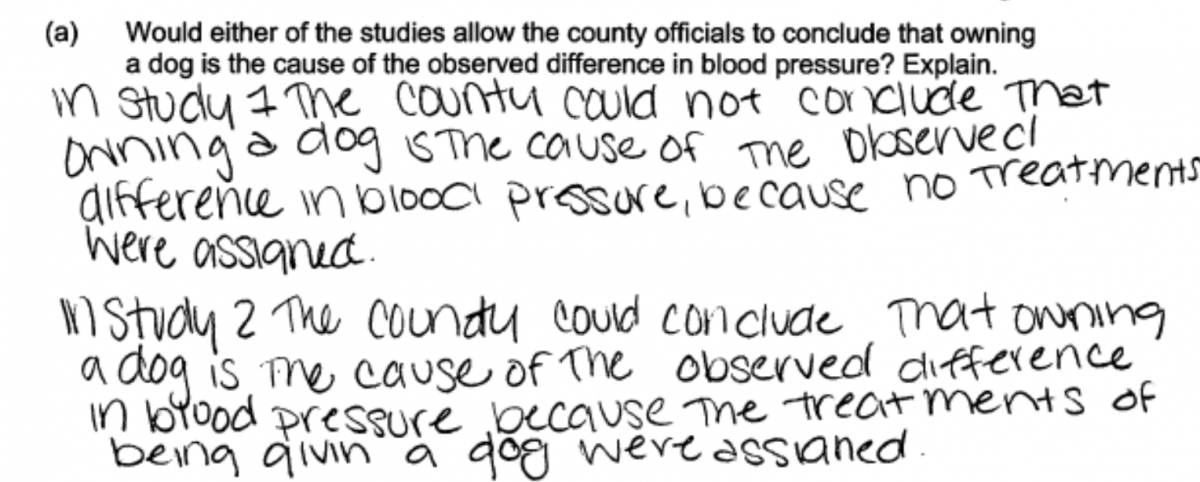
The following two student responses show a good understanding for part (b) of this question. These responses recognize the need for random samples in order to generalize from a sample to a larger population. Both of these responses were scored as essentially correct for part (b). (Note that the second student response uses “SRS” which is a commonly used abbreviation for simple random sample.)


Common misunderstandings
Common student errors for parts (a) and (b) are discussed below. However, there were two general misunderstandings that affected student responses of both parts of this question.
Common Core standard S-IC.3 indicates that students are expected to recognize the purposes of and differences between observational studies and experiments and to understand the role of randomization in each. This means that students should be looking for random selection in a well-designed observational study (so that it is likely that a sample is representative of the population) and for random assignment in a well-designed experiment (so that cause-and-effect conclusions are reasonable). Many student responses did not demonstrate an understanding of these ideas. This conceptual error is illustrated in the following two student responses, which indicate a lack of understanding of the difference between an observational study and an experiment and which fail to distinguish between random selection and random assignment.
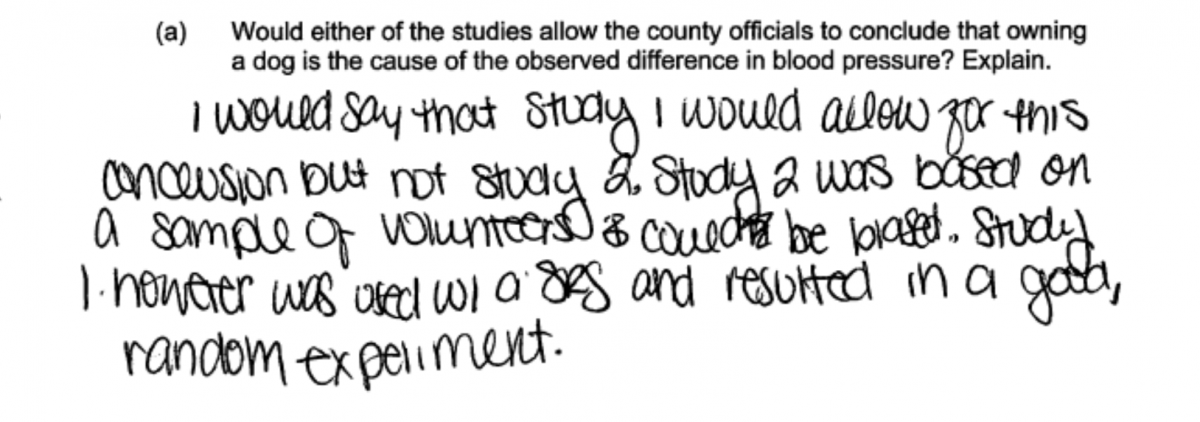
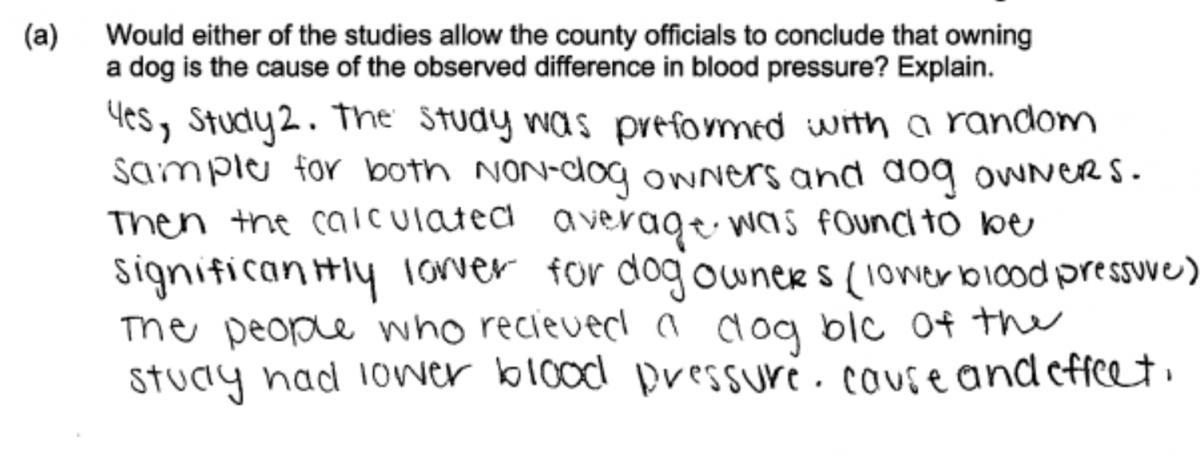
Some students did not understand that the wording “Would either of the studies…” meant that they could say yes for one of the Studies and not for the other. These students attempted to answer either yes for both studies or no for both studies for each part of the question. The following is typical of student responses who interpreted the questions posed in this way.
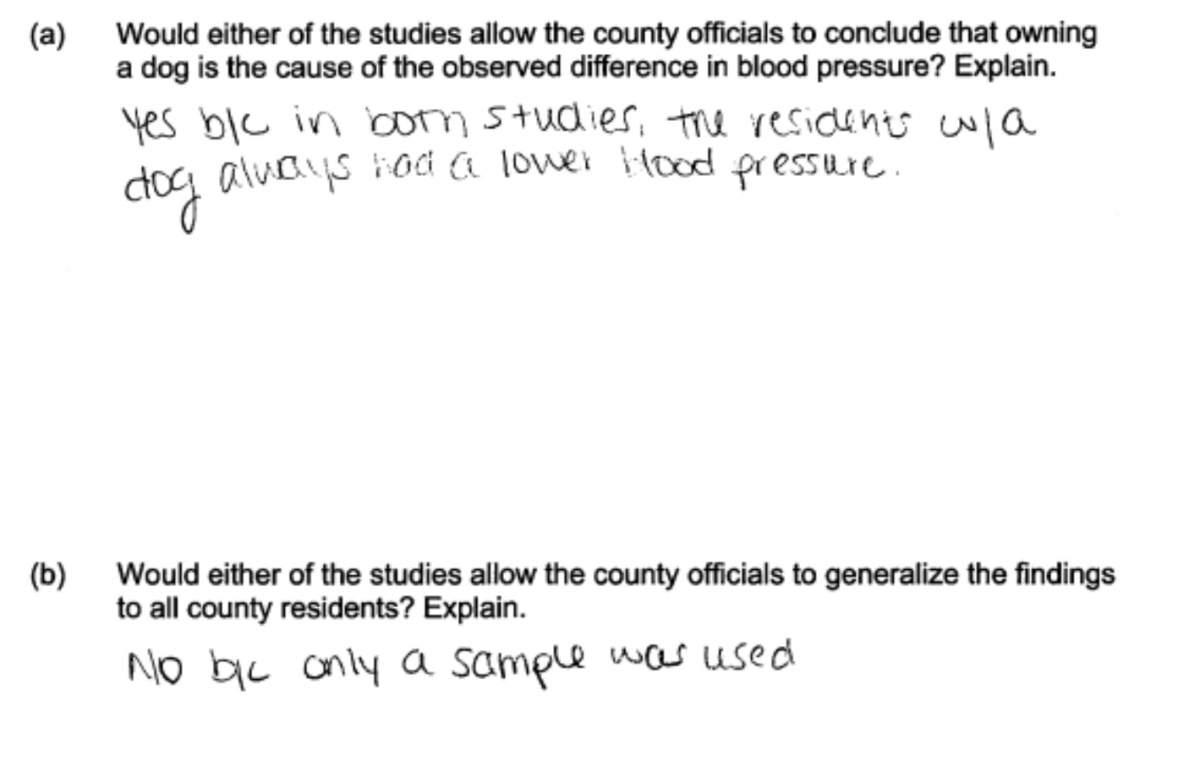
Part (a): Recognize when it is reasonable to draw a cause-and-effect conclusion based on the design of a statistical study.
Some students indicated an understanding that Study 2 was an experiment and that it is only reasonable to reach a cause-and-effect conclusion based on a well-designed experiment. However it was common for these students to provide a weak or incomplete conclusion. The most common mistake here was to not specifically comment on the random assignment of subjects in Study 2. The following two student responses were scored as partially correct for part (a) and illustrate this error.
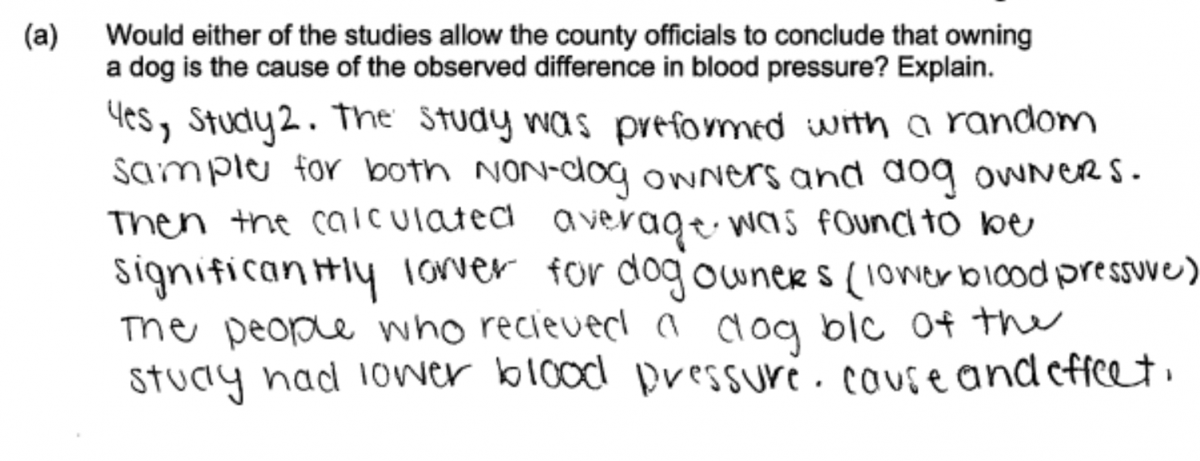

A relatively common student misunderstanding was to confuse statistical significance with causation. Because the question wording used “significantly lower,” these students used statistical significance as the justification of a causal conclusion. This misunderstanding is illustrated in the following two student responses, which were both scored as incorrect for part (a).


Another misunderstanding is illustrated in the following student response. This response indicates that the student believes that it is random selection (rather than random assignment) that is needed in order to draw a causal conclusion. For this reason, the student incorrectly selects Study 1 in the response to part (a).

A few students thought that the conditions that would allow a cause-and-effect conclusion to be drawn were the conditions needed in order for use of a formal inference procedure (such as a two-sample t-test). Students making this mistake focused on the inference conditions rather than the study design in their responses.

Finally, some students did not recognize that Study 2 was an experiment. This is illustrated by the following student response, which was scored as incorrect for part (a).

Part (b): Recognize when it is reasonable to generalize from a sample to a larger population based on the design of a statistical study.
The most common student error in part (b) was failure to specifically appeal to random selection as the explanation for why results could be generalized from Study 1. For example, the following student response was scored as only partially correct because it does not mention that the samples were random samples. If the response had used “random samples” rather than “samples” in the last sentence of the response, it would have been scored as essentially correct.
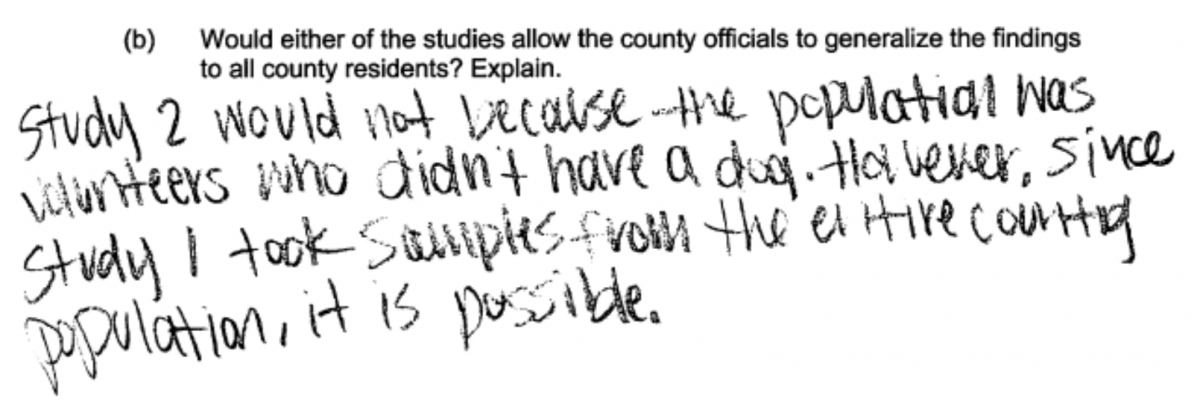
The other two common student errors on part (b) were related to thinking that sample size is what determines whether or not a sample is representative of the population. Some students indicated that they believed that results could be generalized because the sample sizes were large. Others indicated that the results could not be generalized because the samples were not large enough. But in both cases, students making either of these two errors failed to recognize the importance of random selection.
Each of the following three student responses indicate that generalization is justified because the sample sizes are large, and fail to recognize that the reason that generalization can be justified is that the samples were randomly selected.



Each of the following three student responses indicate that generalization is not justified because the sample sizes are too small, and fail to recognize that generalization can be justified because the samples were randomly selected.
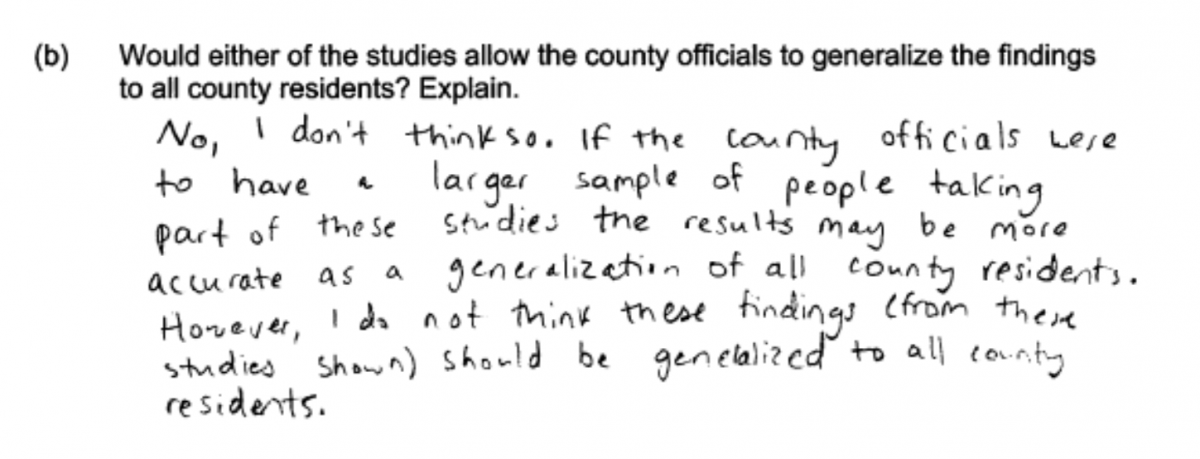


Resources
Resources
Free Resources
Classroom and Assessment Tasks
Illustrative Mathematics has peer reviewed tasks that are indexed by Common Core Standard. A task that focuses on the role of study design in the type of conclusion that can be drawn and could be the basis of a productive classroom discussion is:
Guidelines for Assessment and Instruction in Statistics Education (GAISE)
Published by the American statistical Association and available online, this document contains a discussion of observational studies and experiments on pages 52 – 55.
Resources from the American Statistical Association
Making Sense of Statistical Studies is a collection of investigations suitable for classroom use. The Introduction provides an overview of the types of statistical studies (pages 1 – 2). There is also further discussion of observational studies and the importance of random selection (pages 10 – 13) and of experiments and the importance of random assignment (pages 62 – 66).
Resources from the National Council of Teachers of Mathematics
The NCTM publication Developing Essential Understanding of Statistics in Grades 9 –12 includes a discussion of the following essential understanding: Random selection and random assignment are different things, and the type and scope of conclusions that can be drawn from data depend on the role of random selection and random assignment in the study design (see pages 65 – 66). This discussion is relevant to the content assessed in this question.
The NCTM publication Putting Essential Understanding of Statistics into Practice, 9 - 12 includes a discussion of random assignment and random selection (see pages 60 – 64).
The NCTM publication Navigating through Data Analysis in Grades 9 – 12 includes a chapter on designing studies and explores the types of conclusions that are reasonable for different types of studies (see Chapter 4 titled “Designing Studies”).



